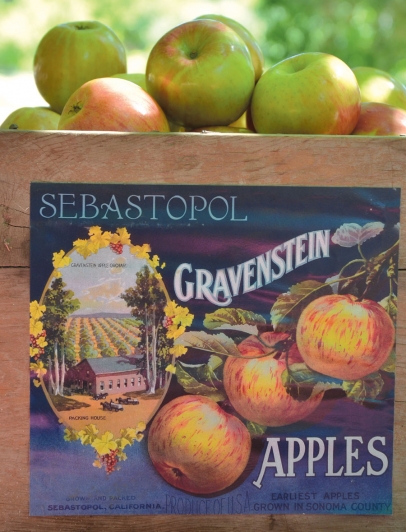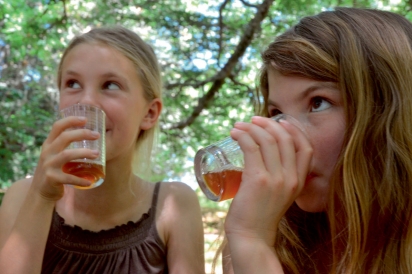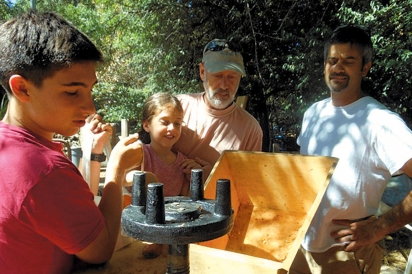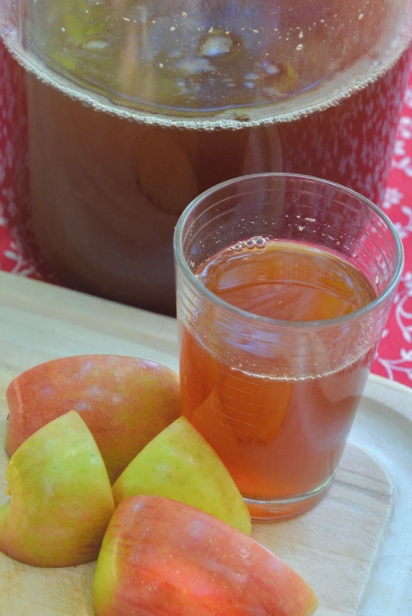Get Juiced at Sebastopol’s Community Apple Press
Come one, come all. Come press your apples at the Community Apple Press at the Luther Burbank Gold Ridge Experiment Farm in Sebastopol this apple season. For free!
Have a backyard full of apples? Someone else’s backyard full? Or a real deal on a bushel’s worth? Gleaning a few? Bring ’em all. Or buy some on the way at local roadside stands, farmers’ markets or even at a store. It’ll be the best juice you ever tasted.
Community pressing has been offered at Sonoma’s Olive Press and Petaluma’s McEvoy Ranch for several years, where anyone can bring olives from one tree or a whole orchard and take back olive oil in proportion to what you brought in, but never before for apples.
And who do we have to thank for this unique and wonderful opportunity? Slow Food Russian River, a local chapter of Slow Food, the international organization that was founded in 1989 to “counteract fast food and fast life,” according to its website.
Slow Food Russian River is an extraordinarily active and successful chapter of Slow Food whose activities showcase and support good, clean and fair agriculture and food in Sonoma County. The group’s wide range of offerings include a monthly book group, a summer film series and education through its website, blog, newsletter and social media outreach. The organization has also spearheaded important long-term projects including local school gardens, the Gravenstein Apple Presidium and the Heritage Turkey Project in partnership with 4-H.
WHY SEBASTOPOL?
Because Sebastopol, with all of its current political progressiveness, also once produced a huge crop of Gravenstein apples, now on Slow Food’s “endangered list.”
The history of apple growing in our area is long and storied, beginning around 1811 when Russian explorers planted apples and other crops around Fort Ross.
Mitchell Gilliam and his son-in-law, Isaac Sullivan, arrived in what is now Graton, known then as Green Valley, in the 1850s and planted a 150-tree apple orchard with stock they bought in Petaluma for $1.50 per tree. After the trees began to yield apples, the pair sold fruit door-to-door in a horse-drawn wagon.
Around the same time, many others in the area were beginning to plant apple trees as well, launching Sebastopol to a national reputation for its apples. All kinds of apples, but it was and is the Gravenstein that holds a special place in Sebastopol’s apple lore.
Nathaniel Griffith, called the “Grandfather of the Gravenstein” locally, planted his orchard off Laguna Road in 1883 and worked with renowned plant breeder and grafter Luther Burbank to develop the distinctive apple, recognized by its yellowish undercoating, naturally decorated with orange and red striping, although several other people and even countries claim its origin. In fact, Denmark claims it as a “native,” discovered in 1669 in Grasten in South Jutland. In 2005, the country’s Food Minister proclaimed the Gravenstein to be the “national apple” of Denmark. In the early 19th century, Charles Ramage Prescott grew the first Canadian Gravensteins in his orchard at Acacia Grove and became the father of the Nova Scotian apple industry.
But there’s no disputing Western Sonoma County’s illustrious place in apple growing history. When early area pioneer Thomas Barlow died at the age of 34, he left his widow with six children and 600 acres planted to apples and blackberries in Green Valley. Mrs. Barlow continued her husband’s ranching enterprise after his death, and two of their sons launched the applesauce canning industry in the area in 1939. Hence, The Barlow commercial development in downtown Sebastopol that includes an old canning shed and many metal buildings designed to resemble canning buildings.
Like many of the immigrant farmers pouring into the area, enterprising Swedes John and Neta Hallberg settled on 40 acres near Sebastopol, planted apple trees and built one of the first apple dryers in California. The Hallbergs’ dryer burned down in 1905. In fact, all but 15 of the estimated 101 local dryers operating during this period burned to the ground eventually. Apparently this was not a finite science.
By the 1890s, locals had also planted wine grapes in the area, after learning how well Agostón Haraszthy’s winery was going in Sonoma (now Jean-Charles Boisset’s Buena Vista Winery).
In 1910, the Sebastopol Apple Growers Union started the Sebastopol Gravenstein Apple Show, now called the Gravenstein Apple Fair and still held every August. In “the good ol’ days,” the whole community chipped in to make float-like sculptures decorated entirely with apples, somewhat like floats covered with flowers for Pasadena’s Rose Parade. Apple-covered structures ranged from buildings and local landmarks to a depiction of the ocean liner Titanic.
By 1911, Sebastopol-area Gravenstein apple growers were shipping 100,000 tons or 500 rail carloads of apples, progressing to an added 18,000 tons of dried fruit, cider and vinegar made from apples by 1919, according to the Western Sonoma County Historical Society. A full wooden box would sell for somewhere between $2.35 and $2.75 at the time.
During World War II, many Japanese immigrant apple growers in the area were rounded up by the federal government and sent to internment camps around the United States and Canada. In most cases, interned Japanese farmers lost all of their property. But not in Sebastopol. According to the Historical Society, “70 to 80 percent of those interned returned to the Sebastopol area. Many had friends and neighbors who stepped in, ran their ranches, and harvested and sold the crops so that taxes could be paid.”
When you bite into a Gravenstein, your sense of smell and the apple’s juices almost beat it to your taste buds. Thought to be one of the besttasting apples for eating out of hand or for use in baking, Gravensteins are usually ready for picking in July or August, earlier than most apples. While a century ago they held up relatively well on long shipping routes, by today’s standards they have acquired a reputation for spoiling quickly—one of the reasons farmers cite as they pull the trees out, often to be replaced by grape vines. The truth is, wine grapes bring a lot more money in the commercial marketplace than apples.
Currently, only six commercial growers of Gravensteins remain in Sonoma County, producing a combined total of 15,000 tons of the famed apples a year, according to SlowFoodUSA.com. And many of the apple-processing plants northwest of Sebastopol have been replaced with other businesses.
HOPE FOR THE FUTURE
Young farmers in our area, and we are fortunate to have a significant number of enterprising and conscientious young farmers here, are beginning to replant Gravenstein and other apple trees, as part of an overall recognition of the value of tasty and nutritious foods, especially those with proven historical success in our area.
The Sonoma School Garden Project, of which I am founder and director, has planted at least one Gravenstein at each of our 11 public school gardens.
And, of course, the Slow Food Russian River group has been an extraordinary supporter and promoter of the preserving and replanting of the Gravenstein. In addition to working to have the Gravenstein named as a special Presidium project of Slow Food International, one of only five in the United States, Paula Downing, a Slow Food Russian River board member and the coordinator of the Apple Corps, an aptly named team within the Slow Food Russian River organization that also includes Paula Shatkin and Bob Burke, tells me that the group places boxes of free Gravenstein apples around Sebastopol and doles out free samples of apple juice at farmers’ markets during the season. Further afield, the group also successfully persuaded restaurants, including Berkeley’s Chez Panisse, to feature Gravensteins on their menus.
The group also applied for and received the Community Benefit Grant from the Sebastopol City Council that allowed the purchase of the apple press.
Between the efforts of all of these good folks, our beloved Gravenstein apples are working their way back into fashion. Now it’s your turn to support the effort—and all you have to do is simply enjoy these delicious apples, and their juice. See you at the press!
Slow Food Russian River and the Gravenstein Apple Presidium: SlowFoodRR.org
Community Apple Press: Open to the public by reservation, Saturdays and Sundays, August 15–October, 2015. For more information and reservations contact Paula Shatkin at 707.876.3221 or pdshat@sonic.net. The press is located at the Luther Burbank Gold Ridge Experiment Farm, 7777 Bodega Ave., Sebastopol. WSCHSGRF.org/luther-burbank-gold-ridge-experiment-farm
Gravenstein Apple Fair: August 8 and 9, 2015, at Ragle Ranch Park, Sebastopol. GravensteinAppleFair.com
Kathleen Thompson Hill is food and wine editor of the Sonoma Index- Tribune, co-author of a series of guide books to wine regions of the West Coast, culinary historian and host of the “Kathleen Hill Show” on KSVY.








